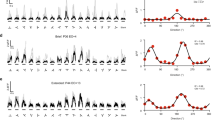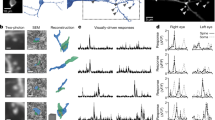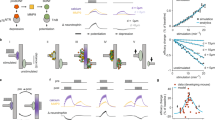Abstract
Activity-dependent models for cortical simple-cell receptive field development predict specific patterns of correlated neural activity within the visual pathway, such as a Mexican hat–shaped pattern of correlated activity in the lateral geniculate nucleus (LGN). However, such activity patterns have yet to be experimentally demonstrated. We performed multielectrode recordings in the LGN of immature awake ferrets and found simple fall-off–shaped, rather than Mexican hat–shaped, patterns of correlated activity. A weak surround in the LGN neuron's receptive field and the statistics of the input contributed to this pattern of correlated activity. Computer simulation of cortical receptive field development incorporating the experimentally observed activity patterns demonstrated that a simple-cell receptive field emerges when a newly devised 'split' constraint on synaptic growth is combined with Hebbian synaptic modification rules. Thus, given certain developmental constraints on synaptic plasticity, patterns of correlated activity within the LGN are compatible with Hebbian models of simple-cell receptive field development.
This is a preview of subscription content, access via your institution
Access options
Subscribe to this journal
Receive 12 print issues and online access
$209.00 per year
only $17.42 per issue
Buy this article
- Purchase on Springer Link
- Instant access to full article PDF
Prices may be subject to local taxes which are calculated during checkout




Similar content being viewed by others
References
Shatz, C.J. Impulse activity and the patterning of connections during CNS development. Neuron 5, 745–756 (1990).
Goodman, C.S. & Shatz, C.J. Developmental mechanisms that generate precise patterns of neural connectivity. Cell 72, 77–98 (1993).
Katz, L.C. & Shatz, C.J. Synaptic activity and the construction of cortical circuits. Science 274, 1133–1138 (1996).
Weliky, M. Correlated neural activity and visual cortical development. Neuron 27, 427–430 (2000).
Hubel, D.H. & Wiesel, T.N. Receptive fields, binocular interaction and functional architecture in the cat's visual cortex. J. Physiol. (Lond.) 160, 106–154 (1962).
Chapman, B. & Stryker, M.P. Development of orientation selectivity in ferret visual cortex and effects of deprivation. J. Neurosci. 13, 5251–5262 (1993).
Weliky, M. & Katz, L.C. Disruption of orientation tuning in visual cortex by artificially correlated neuronal activity. Nature 386, 680–685 (1997).
Chapman, B. & Godecke, I. Cortical cell orientation selectivity fails to develop in the absence of ON–center retinal ganglion cell activity. J. Neurosci. 20, 1922–1930 (2000).
Crair, M.C., Gillespie, D.C. & Stryker, M.P. The role of visual experience in the development of columns in cat visual cortex. Science 279, 566–570 (1998).
White, L.E., Coppola, D.M. & Fitzpatrick, D. The contribution of sensory experience to the maturation of orientation selectivity in ferret visual cortex. Nature 411, 1049–1052 (2001).
Hebb, D.O. The Organization of Behavior (Wiley, New York, 1949).
von der Malsburg, C. Self-organization of orientation sensitive cells in the striate cortex. Kybernetik 14, 85–100 (1973).
Willshaw, D.J. & von der Malsburg, C. How patterned neural connections can be set up by self-organization. Proc. R. Soc. Lond. B 194, 431–445 (1976).
Miller, K.D. A model for the development of simple cell receptive fields and the ordered arrangement of orientation columns through activity-dependent competition between ON- and OFF-center inputs. J. Neurosci. 14, 409–441 (1994).
Price, D.J. & Morgan, J.E. Spatial properties of neurons in the lateral geniculate nucleus of the pigmented ferret. Exp. Brain Res. 68, 28–36 (1987).
Tavazoie, S.F. & Reid, R.C. Diverse receptive fields in the lateral geniculate nucleus during thalamocortical development. Nat. Neurosci. 3, 608–616 (2000).
Mastronarde, D.N. Correlated firing of retinal ganglion cells. Trends Neurosci. 12, 75–80 (1989).
Weliky, M. & Katz, L.C. Correlational structure of spontaneous neuronal activity in the developing lateral geniculate nucleus in vivo. Science 285, 599–604 (1999).
Chiu, C. & Weliky, M. Spontaneous activity in developing ferret visual cortex in vivo. J. Neurosci. 21, 8906–8914 (2001).
Krug, K., Akerman, C.J. & Thompson, I.D. Responses of neurons in neonatal cortex and thalamus to patterned visual stimulation through the naturally closed lids. J. Neurophysiol. 85, 1436–1443 (2001).
Akerman, C.J., Grubb, M.S. & Thompson, I.D. Spatial temporal properties of visual responses in the thalamus of the developing ferret. J. Neurosci. 24, 170–182 (2004).
Chapman, B., Stryker, M.P. & Bonhoeffer, T. Development of orientation preference maps in ferret primary visual cortex. J. Neurosci. 16, 6443–6453 (1996).
Issa, N.P., Trachtenberg, J.T., Chapman, B., Zahs, K.R. & Stryker, M.P. The critical period for ocular dominance plasticity in the ferret's visual cortex. J. Neurosci. 19, 6965–6978 (1999).
Enroth-Cugell, C. & Robson, J.G. The contrast sensitivity of retinal ganglion cells of the cat. J. Physiol. (Lond.) 187, 517–552 (1966).
So, Y.T. & Shapley, R. Spatial tuning of cells in and around lateral geniculate nucleus of the cat: X and Y relay cells and perigeniculate interneurons. J. Neurophysiol. 45, 1107–1120 (1981).
Linsenmeier, R.A., Frishman, L.J., Jakiela, H.G. & Enroth-Cugell, C. Receptive field properties of X and Y cells in the cat retina derived from contrast sensitivity measurements. Vision Res. 22, 1173–1183 (1982).
Field, D.J. Relations between the statistics of natural images and the response properties of cortical cells. J. Opt. Soc. Am. A 4, 2379–2394 (1987).
Hubel, D.H. & Wiesel, T.N. Receptive fields of cells in striate cortex of very young, visually inexperienced kittens. J. Neurophysiol. 26, 994–1002 (1963).
Albus, K. & Wolf, W. Early post-natal development of neural function in the kitten's visual cortex: a laminar analysis. J. Physiol. (Lond.) 348, 153–185 (1984).
Miller, K.D. & Mackay, D.C. The role of constraints in Hebbian learning. Neural Comput. 6, 100–126 (1994).
Miller, K.D. Synaptic economics: competition and cooperation in synaptic plasticity. Neuron 17, 371–374 (1996).
Usrey, W.M., Sceniak, M.P. & Chapman, B. Receptive fields and response properties of neurons in layer 4 of ferret visual cortex. J. Neurophysiol. 89, 1003–1015 (2003).
Daniels, J.D., Pettigrew, J.D. & Norman, J.L. Development of single-neuron response in kitten's lateral geniculate nucleus. J. Neurophysiol. 41, 1373–1393 (1978).
Tootle, J.S. & Friedlander, M.J. Postnatal development of receptive field surround inhibition in kitten dorsal lateral geniculate nucleus. J. Neurophysiol. 56, 523–541 (1986).
Cai, D., DeAngelis, G.C. & Freeman, R.D. Spatiotemporal receptive field organization in the lateral geniculate nucleus of cats and kittens. J. Neurophysiol. 78, 1045–1061 (1997).
Dubin, M.W. & Cleland, B.G. Organization of visual inputs to interneurons of lateral geniculate nucleus of the cat. J. Neurophysiol. 40, 410–427 (1977).
Akerman, C.J., Smyth, D. & Thompson, I.D. Visual experience before eye-opening and the development of the retinogeniculate pathway. Neuron 36, 869–879 (2002).
Ringach, D.L. Haphazard wiring of simple receptive fields and orientation columns in visual cortex. J. Neurophysiol. 92, 468–476 (2004).
Tanaka, S. Theory of self-organization of cortical maps: mathematical framework. Neural Netw. 3, 625–640 (1990).
Miller, K.D., Keller, J.B. & Stryker, M.P. Ocular dominance column development: analysis and simulation. Science 245, 605–615 (1989).
Bienenstock, E.L., Cooper, L.N. & Munro, P.W. Theory for the development of neuron selectivity: orientation specificity and binocular interaction in visual cortex. J. Neurosci. 2, 32–48 (1982).
Lee, A.B., Blais, B., Shouval, H.Z. & Cooper, L.N. Statistics of lateral geniculate nucleus (LGN) activity determine the segregation of ON/OFF subfields for simple cells in visual cortex. Proc. Natl. Acad. Sci. USA 97, 12875–12879 (2000).
Elliott, T. & Shadbolt, N.R. Multiplicative synaptic normalization and a nonlinear Hebb rule underlie a neurotrophic model of competitive synaptic plasticity. Neural Comput. 14, 1311–1322 (2002).
Fiser, J., Chiu, C. & Weliky, M. Small modulation of ongoing cortical dynamics by sensory input during natural vision. Nature 431, 573–578 (2004).
Acknowledgements
This work was supported by US National Institutes of Health (National Eye Institute). T.O. acknowledges the Japan Society for the Promotion of Science for their support. We thank S. Hussain for a critical reading of the manuscript and C. Chiu for surgical assistance.
Author information
Authors and Affiliations
Corresponding author
Ethics declarations
Competing interests
The authors declare no competing financial interests.
Supplementary information
Supplementary Fig. 1
100 ms is an appropriate bin size for detecting negatively correlated activity between neurons with opposite center sign (ON versus OFF). (PDF 736 kb)
Supplementary Fig. 2
Strength of correlated activity (mean r ± s.d.) of each LGN pair plotted as a function of their receptive field separation. (PDF 939 kb)
Rights and permissions
About this article
Cite this article
Ohshiro, T., Weliky, M. Simple fall-off pattern of correlated neural activity in the developing lateral geniculate nucleus. Nat Neurosci 9, 1541–1548 (2006). https://doi.org/10.1038/nn1799
Received:
Accepted:
Published:
Issue Date:
DOI: https://doi.org/10.1038/nn1799
This article is cited by
-
Statistics and geometry of orientation selectivity in primary visual cortex
Biological Cybernetics (2014)
-
Developmental models of functional maps in cortex
Biomedical Engineering Letters (2013)
-
Generalized spin models for coupled cortical feature maps obtained by coarse graining correlation based synaptic learning rules
Journal of Mathematical Biology (2012)
-
Retinal origin of orientation maps in visual cortex
Nature Neuroscience (2011)



